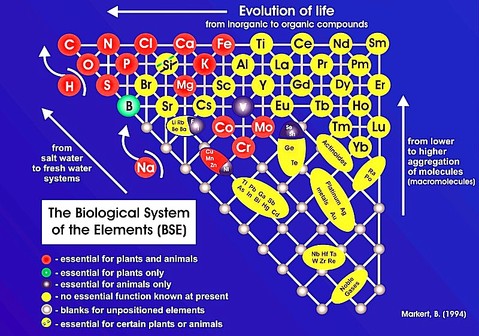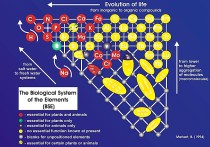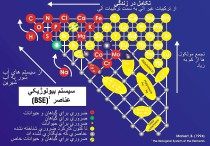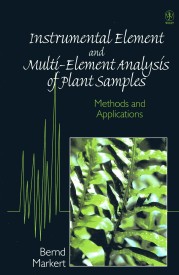The Biological System of the Elements (BSE)
Due to the inadequate chemical description of the biological and medical relationship in the Chemical System of Elements, from the previously mentioned findings a first Biological System of the Elements (BSE) has been established by Prof. Dr. Bernd Markert (Markert 1994, 1996).
The BSE compiled from data on correlation analysis, physiological function of the individual elements in the living organisms, evolutive development out of the inorganic environment, and with respect to their uptake form by the plant organism as a neutral molecule or charged ion. The elements H and Na exercise various functions in the biological system so that they are not conclusively fixed. The ringed elements can at present only be summarized as groups of elements with a similar physiological function since there is a lack of correlation data.
Please have a look to the figure of the BSE, that is translated into more than ten different languages (below you can see the BSE
figures in English and Persian language).
[please click on the figures; left: English-, right: Persian language]
Figure: The Biological System of the Elements (BSE) compiled from data on correlation analysis, physiological function of the individual elements in the living organisms, evolutive development out of the inorganic environment, and with respect to their uptake form by the plant organism as a neutral molecule or charged ion. The elements H and Na exercise various functions in the biological system so that they are not conclusively fixed. The ringed elements can at present only be summarized as groups of elements with a similar physiological function since there is a lack of correlation data or else these data are too imprecise (Markert 1994).
Metal ions generally share the ability/tendency to interact with biological material by forming complexes, except possibly for the heavy alkali metals K, Rb and Cs – regardless of the metals being essential for sustaining life and its reproduction, apparently insignificant for biology through perhaps undergoing bioconcentration or outright toxic even at low admission levels. Hence the various features of metal-biomass interaction should in some way depend on properties describing coordination chemistries of these very metals:
while essential metals should have common parameters with others being used in biology the numeries will distinguish them from non-essential and/or toxic ones. These above figures include all bioconcentration, the involvement of metal ions such as Zn, Mg, Cu, Fe etc. in biocatalysis as crucial components of metalloenzymes and the introduction of a certain set of essential metals common to (almost) all living beings (K, Mg, Mo, Mn, Fe, Cu and Zn) which occurred probably very early in biological evolution, that is, the ‘natural selection of the chemical elements’.
[please click on the figure]
For further information especially to the evolution of the BSE see Markert (1993 , 1997), Fränzle & Markert (2000a,b, 2002), and for more detailed information especially referred to the mineral nutrition of plants please have a look to the book of Fränzle 2010. Starting with data from biochemical environmental analysis, and a discussion of the phenomena involved in metal ion partition and autocatalytic behaviour, conditions and criteria controlling the partition of metals into biomass are investigated. Several rules are derived and investigated in terms of their interaction both in comparisons among contemporary organisms and in terms of evolution. This allows the construction, for example of a map which directly traces the biological feature of essentiality to parameters of coordination chemistry.
Future: The authors Markert, Fränzle and Wünschmann are going to publish a new book on "Evolution of Life - Derived by the Biological System of the Elements".












